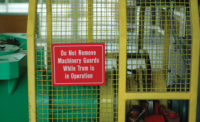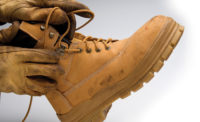OK, you’ve read other articles on emergency showers and eyewashes. You know that the distance from a corrosive material to an eyewash needs to be no more than 10 seconds and that the flushing fluid temperature must be tepid.
You’re probably already testing your emergency equipment weekly and you’ve also read that a new ANSI/ISEA Z358.1 standard was published in January 2015.
The key requirements didn’t change, so why another article on emergency showers and eyewashes?
Since the OSHA requirement for showers and eyewashes is quite broad, understanding the diverse range of locations where these products should be used will help make your facilities safer for employees who are working with hazardous materials.
Let’s start with a quick review of OSHA 29 CFR 1910.151(c): “Where the eyes or body of any person may be exposed to injurious corrosive materials, suitable facilities for quick drenching or flushing of the eyes and body shall be provided within the work area for immediate emergency use.”
Now let’s look at how to identify areas of need, and some off the beaten path areas, where you might not typically think of providing an emergency shower or eyewash.
Road map for hazard identification
One of the easiest ways to identify hazardous substances that require showers and eyewashes for protection is to use OSHA’s Hazard Communication Standard (29 CFR 1910.1200) and the Globally Harmonized System of Classification and Labelling of Chemicals (GHS) as a roadmap. The universal symbols/pictograms used on labels and containers provide clear indications if a chemical is a corrosive, irritant, flammable, etc. The accompanying Safety Data Sheet (SDS) will provide clear instructions on the first aid remedies for exposure to the eyes or body.
With our roadmap in place, let’s take a look where some of these chemicals are being used and what type of protection should be available.
Battery charging & maintenance areas
One of the most commonly overlooked applications is where batteries are being charged and maintained. When you think of where vehicle batteries are serviced, it’s not just in car or truck service stations, it’s also in locations that use forklifts, aerial lifts and other warehouse equipment. With the growth in popularity of hybrid and all electric vehicles, the need for protection in service stations will become increasingly important. Other locations where electrical storage batteries are used and maintained are slightly less evident.
What about your cell phone? No, not the battery in your Android Smartphone, but the banks of batteries that are located in cell phone towers to make sure that you have uninterrupted service. And speaking of uninterrupted service, what about battery systems used for energy storage and backup in residential, community and industrial applications?
OSHA Directive Number SRD 01-08-002 provides guidelines for eyewash and body flushing facilities in electric storage battery charging and maintenance areas. At the low end of the spectrum are locations where there is only routine recharging of powered commercial and manufacturing vehicles and equipment. Normally these locations don’t require emergency equipment unless a potential exposure to electrolytes is substantiated.
At the upper end are commercial and manufacturing facilities where batteries are serviced and handled. In these locations plumbed eyewash and body drenching equipment must be available immediately adjacent to the workstation.
Janitors’ closets
Grout and tile cleaners, degreasers, bleach, floor strippers and drain cleaners are among the many chemicals found in your typical janitor’s closets. When evaluating facilities such as office buildings, schools, hotels and hospitals for compliance to ANSI/ISEA Z358.1, the janitor’s closet is often overlooked, despite the fact that these chemicals are used on a regular basis. Reading the SDSs for these typical cleaning agents indicates that personal protective equipment (PPE) should be worn and accidental exposure to the eyes or skin should be treated by washing with plenty of water for 15 minutes.
Janitorial closets are only one of the several places in a hotel where eyewashes should be installed to protect employees. In pools, chlorine is used to kill germs and housekeeping uses chlorine bleach to de-stain, whiten and sanitize linens and towels. Exposure of the eyes or skin to both of these is hazardous, and the recommended first aid treatment is to flush with plentiful quantities of water for 15 minutes.
Let’s consider kitchens in a variety of locations such as hotels, restaurants and hospitals. Oven cleaners and degreasers, commercial dish detergents and cleaning/sanitizing chemicals are used regularly to help keep the food preparation areas, utensils and dishes sanitary and clean. These cleaners contain ingredients such as sodium hydroxide and potassium carbonate that provide great cleaning power but are also hazardous if splashed in the eyes or on the skin.
Big box stores
Continuing off the beaten path… big box stores, local drug stores and even larger grocery stores all have photo processing centers. Employees are required to refill bulk containers of developers, fixers and rinses which can range from mild irritants to severe corrosives. A quick check of the SDS typically reveals rinsing of the eyes for 15 minutes is the recommended first aid treatment.
A risk assessment will help identify the areas of greatest exposure and where showers and/or eyewashes should be located in these venues. Some other places inside big box stores could be the auto and tire department, the paint department and even the lawn and garden department. Employees shaking cans of paint with pigment and then popping off the lids for a color test provides an opportunity to get an eyeful of stain or paint. A busted bag of fertilizer spilling its contents or a leaking container of weed killer or bug spray – none of these products are good to get in the eyes.
Ultimately, the determining factor for placing emergency showers and eyewashes will be a risk assessment of the facility. You want to evaluate the specific chemicals being used and the potential for your employees to be exposed to them. Look for the GHS pictograms as visual symbols of hazards, and then review the SDSs to get specific first aid treatments in case of exposure.
In OSHA’s Three Lines of Defense philosophy, personal protective equipment (PPE) is the last line of defense after engineering and administrative controls. When PPE doesn’t adequately protect the worker and a chemical incident occurs, an emergency shower and/or eyewash with tepid water is required within 10 seconds of travel distance according to ANSI/ISEA Z358.1


